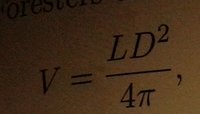Probability
Full Member
- Joined
- Jan 26, 2012
- Messages
- 432
I have a tree trunk and I want to estimate the volume. I measure the length and find it to be 1.5 m. I put a tape measure round the trunk and calculate the circumference to be 92 cm.
Using the formula;
V = L x D^2 / 4 x pie
I calculate the volume; hence
V = 1.5 x 0.92^2 / 4 / pie
V = 0.10 m^3 (to 2 s.f.)
I'm then asked to carryout the same calculation using a calculator. In this example I'm using a CASIO fx-85GT PLUS
I'm told that the most obvious way of calculating the above using a calculator is to use the fraction function. An alternative way is to use the division key.
using the fraction function;
1.5 x 0.92^2 / 4 / pie = 0.997... (This example is exactly has I typed it in the calculator)
Now I tried this method;
1.5 x (92/100)^2 / 4 / pie = 0.997... (this example uses parenthesis)
1.5 x (92/100^2) / 4 / pie = 1.098... (this example squared everything in the parenthesis)
This method was even worse;
1.5 x (92^2/100) / 4 / pie = 10.103... (this example I squared the 92)
I can't seem to get the correct answer using the fraction function of a calculator. The correct answer is 0.10 (to 2 s.f.)
Now if I use the division function on the calculator I get;
1.5 x (92/100)^2 / 4 / pie = 0.101.....
Am I missing a technique using the calculator or is this type of problem not able to be solved using the fraction function of calculators?
Using the formula;
V = L x D^2 / 4 x pie
I calculate the volume; hence
V = 1.5 x 0.92^2 / 4 / pie
V = 0.10 m^3 (to 2 s.f.)
I'm then asked to carryout the same calculation using a calculator. In this example I'm using a CASIO fx-85GT PLUS
I'm told that the most obvious way of calculating the above using a calculator is to use the fraction function. An alternative way is to use the division key.
using the fraction function;
1.5 x 0.92^2 / 4 / pie = 0.997... (This example is exactly has I typed it in the calculator)
Now I tried this method;
1.5 x (92/100)^2 / 4 / pie = 0.997... (this example uses parenthesis)
1.5 x (92/100^2) / 4 / pie = 1.098... (this example squared everything in the parenthesis)
This method was even worse;
1.5 x (92^2/100) / 4 / pie = 10.103... (this example I squared the 92)
I can't seem to get the correct answer using the fraction function of a calculator. The correct answer is 0.10 (to 2 s.f.)
Now if I use the division function on the calculator I get;
1.5 x (92/100)^2 / 4 / pie = 0.101.....
Am I missing a technique using the calculator or is this type of problem not able to be solved using the fraction function of calculators?

